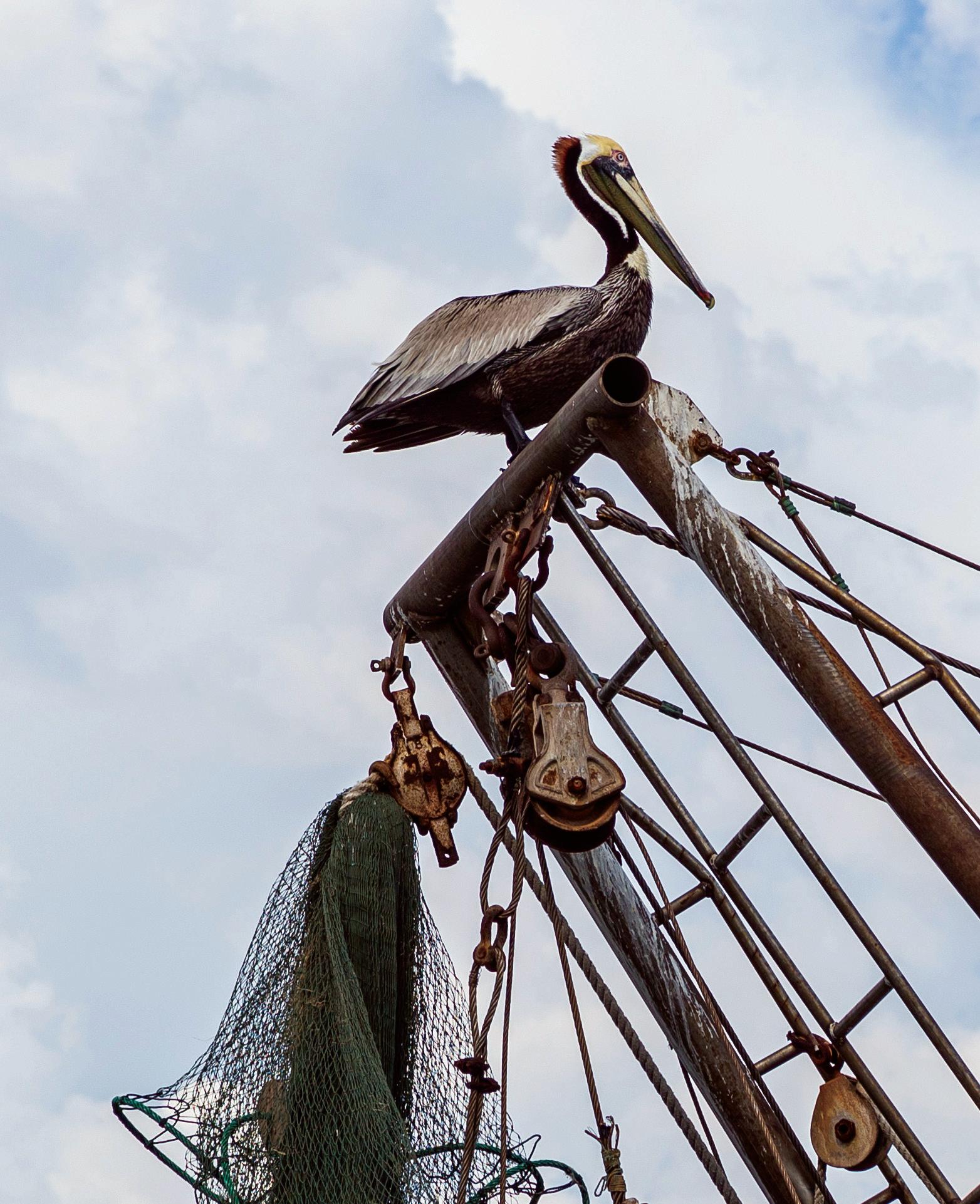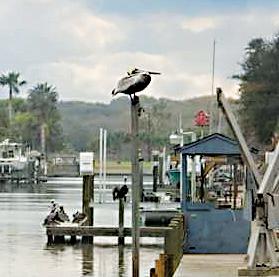
8 minute read
Birds of the Coastal Bend
LAUGHING GULL
Thousands of feathered species make their home along the shores of the Lone Star State. Each year, more than 450 bird species fly to and around the great Texas Coastal Birding Trail.
Advertisement

WHOOPING CRANE
With plenty of marsh land and warmer temperatures, the Coastal Bend is an ideal location for birds like the Whooping Crane, Sand Hill Crane, Brown Pelican and Blue Heron to call home year-round for a season.
For the tallest bird in North America, the Coastal Bend area is its winter destination.
“Texas is truly the ancestral home of the modern Whooping Crane. When the bird’s population dropped to below 20 in the 1940s, every single Whooping Crane on earth was right here in Aransas National Wildlife Refuge. These birds found their salvation in Texas and we believe that they’ll continue to be saved from extinction by Texans who care about them,” said Anna Turkett, Whooping Crane Outreach Coordinator for the International Crane Foundation in Rockport.
An estimated 504 Whooping Cranes of a total of 849 in the world are expected to winter in Texas this year.
Whooping cranes stand nearly five-feet tall with a wingspan between seven and eight feet. This bird nests
(continued on page 10)

in Wood Buffalo National Park in Canada then migrates to Aransas National Wildlife Refuge to winter.
“Texas offers them a magnificent winter home to raise their chicks, those chicks are all hatched at the Wood Buffalo National Park in Canada. Whooping Cranes do not nest in Texas. Their migratory nature means they need wetland habitat and protection in Texas, Canada and all along their migration route from Saskatchewan through the central flyway down to Kansas, Oklahoma and arriving in south Texas,” Turkett said.
The endangered Whooping Crane is the rarest of the cranes and among the oldest living bird species. The migratory flock from Canada is the only wild flock that returns annually to its winter home.
To celebrate these special winter Texans, a Whooping Crane Festival is held each year at Port Aransas & Mustang Island. The festival features guided tours, bird watching, cruises and other special events. The 25th Annual Whooping Crane Festival will be Feb. 24-27, 2022. For information, go online to whoopingcranefestival.org.
Turkett encourages Coastal Bend residents to maintain a high quality, undisturbed marsh and prairie habitat for the unique bird.
“All of us in the Coastal Bend can help the birds by conserving our water usage and valuing our natural landscape. You can also support and follow the International Crane Foundation,” she said.
The International Crane Foundation Team includes Dr. Liz Smith, North America Programs Director and Senior Whooping Crane Scientist; John Pistone, Leiden Conservation Whooping Crane Biologist; and Turkett. All are devoted to working with partner organizations to help ensure the Whooping Cranes remain part of the Coastal Bend wildlife by fostering a passion for Whooping Cranes and conducting scientific research and monitoring that leads to conservation action.
Whooping Cranes live at least 22 years and sometimes as long as 40 years.

SAND HILL CRANE
The Sand Hill Crane also is seen along the coast and protected from hunting in the Corpus Christi area.
The Sand Hill Crane flies in flocks of two to hundreds. Their legs are extended beyond the tail while in flight and they have a slow wingbeat. Their long neck is extended straight forward. They have a wingspan of five feet.
Though gray with dark wingtips, the Sand Hill Crane may appear white when seen in flight.

BROWN PELICAN
Another popular bird in the area is the Brown Pelican. This spectacular bird is a favorite to watch fly across the water in search of a meal. The Brown Pelican soars
(continued on page 12)
Steven A King
Financial Advisor
2527 Highway 361 • Suite C • Ingleside, TX 78362
Bus. 361-775-1091 Fax 866-444-3971
steven.a.king@edwardjones.com
Smart advice, without the pressure. Let’s talk, today.

WHITE PELICAN
over coastal waters then plunges headfirst grabbing a fish. With a fresh meal in his large bill, the Pelican tilts its head down to drain extra water out, then tosses its head back to swallow. They can fly just above the water surface or can dive from as high as 60 feet.
This species was endangered in the 1970s. Thanks to conservation efforts, today there is an abundance of the Brown Pelican in the United States.
According to audubon.org, the oldest recorded Brown Pelican lived to be 43 years old.
The Brown Pelican can be seen yearround and often are in large groups.

WHITE PELICAN
The American White Pelicans may be spotted along the Coastal Bend but are not as common as the Brown Pelican. The White Pelican has white and black wings, large head and huge, heavy bill. They often work together to corral fish to shallow areas and are even known to steal food from each other and fishermen.
The oldest know White Pelican was at least 23 years, six months old and was banded in North Dakota in 1983.
Fowler LUMBER

SINCE 1956
• Lumber • Hardware • Hand Tools • Plumbing & Electrical • Screen Replace & Repair • Large Galvanized & Stainless & Brass Inventory Nuts, Bolts, Pipe & Fittings • Pipe Threading • Mobile Home & RV Parts
Local, Free Delivery

Open Monday-Friday 7-5, Saturday 7-3 361-758-5345
all credit cards accepted 1262 Bus Hwy 35 N | Aransas Pass, TX
If you’re looking for that special gift, you can find it here!

• ANTIQUE FURNITURE • JEWELRY • CANDLES - ASPEN BAY, TRAPP, VOTIVO & CIRCLE E • CHRISTMAS & OTHER HOLIDAY DECOR • DECORATIVE ACCESSORIES AND MORE!
1113 Railroad Ave,
Follow us on Facebook Portland, TX 78374
Tuesday - Saturday 10:30 am - 6:00 pm Closed Sunday & Monday 361-643-8027
The largest of the North American herons’ species is the Blue Heron.
In Texas, the largest colonies are found in the forested east inland region and on the coastal islands. The birds breed in late January to late August.
With a length of 38.2 to 53.9 inches and a wingspan of up to 79.1 inches, this highly adaptable bird can feed at or away from water. They wade slowly, looking much like a statue as they stalk fish and other pray in the shallow water or open fields. Once their catch is spotted, they thrust their neck and head with lightening speed, stabbing the prey with their strong, dagger like bills.
According to Texas A&M AgriLife Extension, Blue Heron breeding plumes were in high demand from 1860-1901. The plumes were used to adorn women’s hats.
GREEN HERON
The Green Heron is the most widespread of Texas Herons, though not much data has been collected for the species.
This bird is a common summer resident throughout the eastern two-thirds of Texas. They are more common in inland wetland areas than along the coast. They primarily are seen from early March to July. In the winter months, they are not often seen along the coast.
ROSEATE SPOONBILL
From March through October, Roseate Spoonbills make their home along the Gulf Coast. In winter, they migrate to Central and South America.
Like the Blue Heron, the Roseate Spoonbill was nearly hunted to extinction during the 1800s. Its beautiful plumage with striking pink feathers were a popular accessory to women’s hats.
This bird grows to a height of 32 inches with an average wingspan of 50 inches. They have a pink body and legs, white neck and breastplate, pale green bald head, spoon-shaped bill and bright red shoulder patch.
The Roseate Spoonbill eats mainly small fish and crustaceans. Unlike most birds, these birds are silent and often eat alone. They are monogamous and their mating season in Texas is during the months of March, April, May, June and July.

OSPREY
A bird of prey, the Osprey appears ready for the hunt. The mostly white head is marked with a black mask extending from the back corner of the eyes through the cheek area and to the sides of the neck. The rest of its body is dark brown to nearly black with solid white on the under parts of the body.
The Osprey winters primarily along the Texas Gulf Coast and southern Mexico.
The bird tends to fly alone, only pairing with another during mating season. Its nest can be as high as 200 feet above the ground.
Its primary diet consists of various fish. The Osprey hovers in a figure-eight pattern over the water, then dives into the water capturing its prey with its long talons. It carries its meal a considerable distance before dining.
These are just a few of the feathered species seen around the Coastal Bend. The coastal area offers a variety of well-known birding sites from Kingsville and Corpus Christi to Goliad and continuing through Port Aransas, Rockport-Fulton and Bay City.
The Texas Coastal Bend Regional Tourism Council website, txcoastalbend.org, offers information on the Great Texas Coastal Birding Trail.
Details for the Great Texas Birding Classic can be found at tpwd.texas.gov. This is the biggest, longest birdwatching tournament in the United States.
According to the website it is for birders of all ages and levels of experience. There are a variety of tournament categories from the backyard birder to the competitive lister. Registration fees raise money for conservation grants.
Sources: Texas Breeding Bird Atlas, Texas Parks and Wildlife Department, Florida Fish and Wildlife Conservation Commission, International Crane Foundation, Wikipedia, Audubon Field Guide and All About Birds. This story is reprinted from the Winter, 2019 Coastal Scene magazine.



Soto Painting Service
Fred Soto, Painting Contractor 302 N. 7th Street Aransas Pass, TX 78336 Cell:(361) 816-3074
Email: fredsoto8@gmail.com


